Previous issue | Next issue | Archive
Volume 5 (4); July 25, 2015 [Booklet]
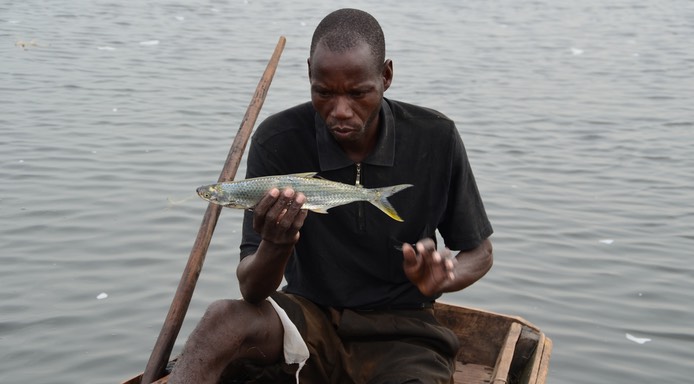 Research Paper
Research Paper
Socio economic characteristics of fishermen in Jabel Awlia and El- Mawrada at Khartoum state, Sudan.
Mohamed Ahmed F.A., Daldoum Daleel E. M, Idres Yagoub A.H, Abd-Al.Saeed Fadlalseed S., Mohammed Salh R.R., Ksrpos Kolia W.S., Mohammed A.A.
Online J. Anim. Feed Res., 5(4): 95-100, 2015; pii: S222877011500016-5
Abstract
The present study aimed to provide baseline information of socio-economic status of Jabel Awlia and El-Mawrada fishery in the White Nile in Sudan due to there is lack of information in this field. Descriptive analysis was done for analyzing the raw data of the study by using Excel Microsoft Software 2003. Social data showed that male fishermen group was dominant in both sites (97.6%, 100%) respectively. Age groups of fishermen ranged between 20 to 70yrs; where age group 31- 40yr was dominant in Jebel Awlia and age group 41-50 was dominant in El-Mawrada. Six educational categories were recorded where primary education was dominant in the two location (48.8%, 44.4%) respectively; whereas, secondary education was the second in the two location (24.4%) and (27.8%) respectively. Part-time fishermen was dominant in both sites (34.1%, 11.1%); whereas full time fishermen was the lowest (4.9%, 16.7%). Most of fishermen were married (85%, 94%) in both sites; whereas ...read more
Keywords: Fishery, Fishermen, Economic, Nile, Fishing.
[Full text-PDF] [XML] [DOAJ]
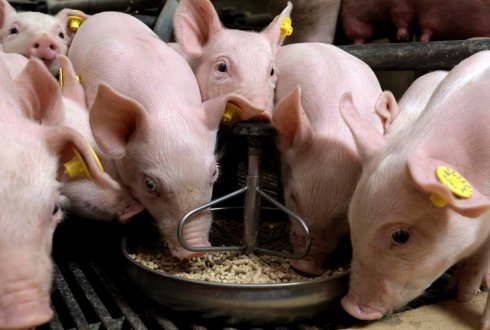 Research Paper
Research Paper
The performance of growing pigs fed diets containing different levels of sodium hydroxide-treated Sheanut kernel cake.
Oddoye E.O.K., Nortey T. N., Owusu Ansah F and Gyedu-Akoto E.
Online J. Anim. Feed Res., 5(4): 101-105, 2015; pii: S222877011500017-5
Abstract
The aim was to investigate the use of sodium hydroxide treated (0.01M) Sheanut kernel cake (TSNKC) as a feed ingredient in growing pig diets. The growth rate, feed intake and feed to gain ratio of growing pigs fed diets containing 100 (100USNKC/control), 100 (100TSNKC), 150 (150TSNKC) or 200 (200TSNKC) g kg-1 of sodium hydroxide treated Sheanut kernel cake was investigated in two feeding trials set up as completely randomized designs with 4 treatments replicated 3 times and lasting 120 days. The two feeding trials were combined and analyzed as a split-plot, with the trials being the main plot and the experiment within the trial as the sub plot. Treatment 100TSNKC was significantly different (P < 0.05) from treatment 200TSNKC. Treatments 100USNKC and 150TSNKC were not significantly different (P > 0.05) from either 200TSNKC or 100TSNKC. Total feed intake for 200TSNKC was significantly lower (P < 0.05) as compared to the other treatments but feed to gain ratio was not significantly different (P > 0.05). It was concluded that it is possible to include up to 150 g kg-1 sodium hydroxide treated Sheanut kernel cake in growing pig diets. Future work will need to look at ways of improving the palatability of sodium hydroxide treated Sheanut kernel cake and also look at carcass analysis and blood profiles.
Keywords: Sheanut, Sodium Hydroxide Treatment, Sheanut Kernel Cake, Growing Pigs, Feeding Trial.
[Full text-PDF] [XML] [DOAJ]
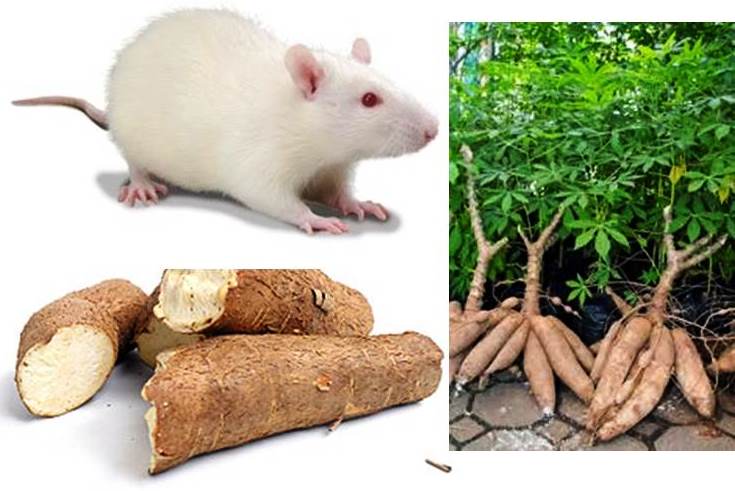 Research Paper
Research Paper
The use of cassava root meal as a partial replacement for corn in diets for albino rats.
Nortey T.N., Arkorful E., Sowah N. A., Naazie A.
Online J. Anim. Feed Res., 5(4): 106-111, 2015; pii: S222877011500018-5
Abstract
The experiment was carried out to determine if partial replacement of maize with cassava root meal (CRM) in diets for albino rats will have an effect on performance, organ characteristics and blood parameters. Twenty five Sprague Dawley albino rats (F344 strain), initial body weight (216 ± 8g) were randomly assigned to five treatments (T1 to T5) in a completely randomized (CRD) arrangement. T1 was the control and contained zero CRM. T2 and T3 contained 30% CRM, while T4 and T5 contained 45% CRM. These levels of inclusion represented 50 and 75% replacement of corn in the diets respectively. T2 and T4 had 0.15% methionine (Met) while T3 and T5 had 0.3% Met. The rats were each fed a single diet for 28d. Average daily feed intake (ADFI) of rats on T1 was lower (P<0.05) than that for rats on T4 and T5 (12.12g vs. 12.77 and 12.64g) respectively. For diets with the same level of CRM, those with 0.3% Met had a lower consumption than those with 0.15% Met. There were no differences (P > 0.05) in average daily gain (ADG) and feed conversion efficiency (FCE). Similarly there were no differences (P>0.05) in carcass, viscera and other internal organ weights. Results of this trial indicate that albino rats can tolerate diets with added CRM (45% of the diet) with no adverse effects on growth and internal organ characteristics. Future work will need to look at the possibility of using CRM at similar or higher levels in diets for growing pigs.
Keywords: Albino Rats, Cassava Root Meal, Performance, Carcass Characteristics, Blood Parameters
[Full text-PDF] [XML] [DOAJ]
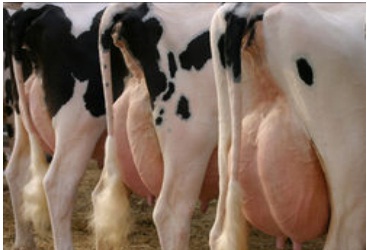 Research Paper
Research Paper
Comparison between the percentage of incidence of mastitis caused by Bacillus spp and Staphylococcus spp in winter season in Khartoum state, Sudan.
Mohammed Salih R.R.
Online J. Anim. Feed Res., 5(4): 112-116, 2015; pii: S222877011500019-5
Abstract
This study was conducted in certain area at Khartoum State (Eltebna, Falasteen, Shambat, Hilat Kuku, Elhalfaia, Elsamrab and The University of Khartoum farms) in winter season to determine the type of mastitis and to compare between the incidence of mastitis caused by Stapylococcus spps and Bacillus spp. The total number of dairy cows, which were examined in 34 investigated farms, amounted to 500 animals, but the number of positive cows infected with mastitis were 100. The milk samples were collected from cows due to complain of owners from clinical cases of mastitis. Hundred milk samples were collected from apparent cases of mastitis. All mastitic cases were examined by visual examination and palpation of the udder: 55% acute mastitis, 44% chronic mastitis and 1% gangrenous mastitis were diagnosed. Milk samples were cultured in Blood agar and MacConkey´s agar for 24 hours at 37º C. The isolation of Bacillus spp. amounted 74% , these constituted 31% Bacillus coagulans, 11% B. cereus, 9% B. subtilis, 9% B. licheniformis, 4% B. circulans, 2% B. lentus, 3% B. mycoides, 3% B. amyloliquefaciens and 2% B. megaterium. The percentages of acute mastitis caused by B. coagulans was 14%, B. subtilis 8%, B. lichneformes 7% and 2% for every followed Bacillus spp. (B. cereus, B. circulans B. lentus, B. mycoides, B. amyloliquefaciens and B. megaterium). The percentage of chronic mastitis caused by Bacillus spp. were as follows: B. coagulans was 17%, B. cereus 9%, 2% for every Bacillus spp. (B. lichneformes, B. circulans and B. lentus) and 1% for every followed Bacillus spp. (B. subtilis, B. mycoides, B. amyloliquefaciens and B. megaterium). Staph aureus and Staph hyicus amounted to 24% and the percentage of chronic mastitis caused by Staph aureus was 44% and that caused by Staph hyicus was 8%. The percentage of acute mastitis caused by each species of Staph was the same 24%. Other bacteria were isolated from mastitic cows Corynebaccterium spp. 1% and Klebsiella spp. 1% and the last one was isolated from gangrenous mastitis as first report in Sudan.
Keywords: Comparison, Incidence, Mastitis, Bacillus Spp., Staphyolcoccus Spp., Cattle, Winter, Khartoum, Sudan.
[Full text-PDF] [XML] [DOAJ]
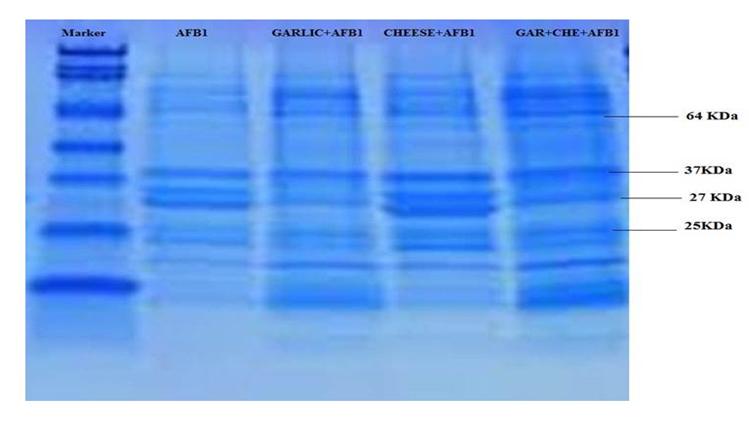 Research Paper
Research Paper
Amelioration effect of probiotics on afb1 induced hematological alterations in fresh water fish Cyprinus carpio L.
Pradeepkiran J.A., and Bhaskar M.
Online J. Anim. Feed Res., 5(4): 117-124, 2015; pii: S222877011500020-5
Abstract
The objective of this study was to examine protective effect of probiotics against aflatoxin B1 (AFB1) on hematological and serum parameters which include the RBC, WBC, albumins, globulins, serum creatinine, and ALT and AST of fresh water fish Cyprinous carpio L. The total hemobiochemical analysis was compared with the AFB1 induced and probiotics (garlic, cheese) treated groups. Cyprinous carpio L. (40 ± 10 g), were randomly divided into five experimental groups (15 fish per group). Group T1 represented the negative control fed with normal diet, and T2 was the positive control group fed with AFB1 contaminated diet. Groups T3, T4 were fed with AFB1-contaminated diet 200ppb supplemented with 2 mg/kg cheese, 2 mg/kg garlic, and Group T5 fed with AFB1-contaminated diet and 4 mg/kg bw (garlic + cheese) probiotic supplementation in 1:1 ratio respectively. Ingestion of AFB1-contaminated fish feed possess the adverse effects on hematological parameters like, total red blood cells numbers, relative number of lymphocytes, monocytes, neutrophils, basophils, and eosinophils in blood. Likewise AFB1 altered globulin, albumins, and total protein concentrations in serum fractions (GroupT2). Supplementation of probiotics cheese alone showed significant protective effect than garlic and in combination group (Group T5). Group 5 showed more or less similar to that of the control, in conclusion probiotics cheese and garlic showed significant combat effects in reducing hematological toxic effects of AFB1.
Keywords: Probiotics, Aflatoxin B1, Hematology, Cheese, Garlic.
Previous issue | Next issue | Archive

This work is licensed under a Creative Commons Attribution-NonCommercial 4.0 International License.
| < Prev | Next > |
|---|


